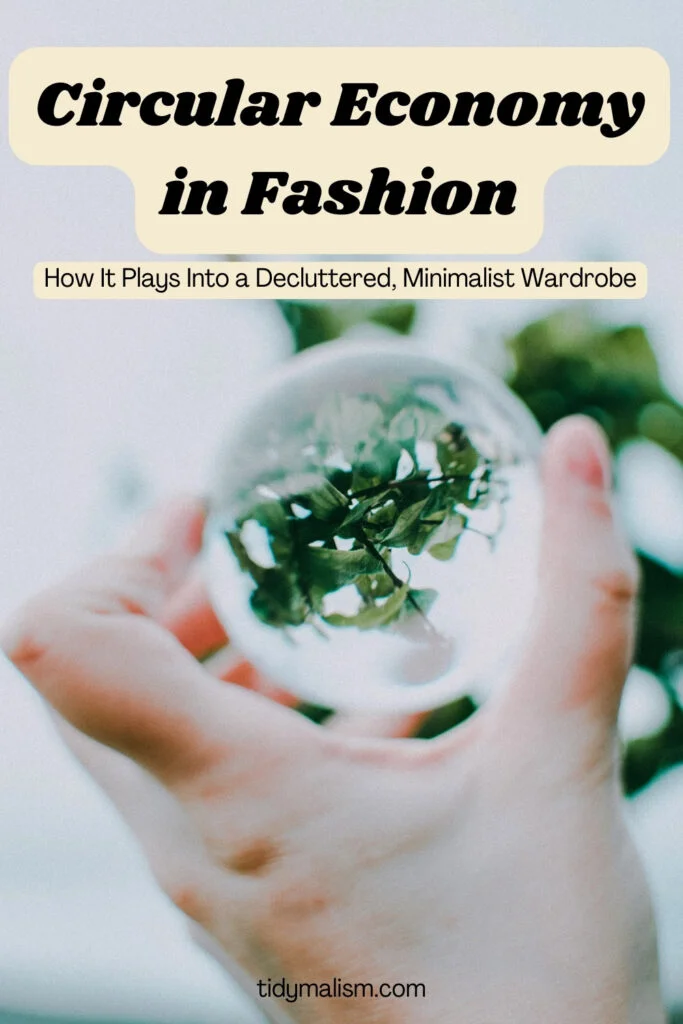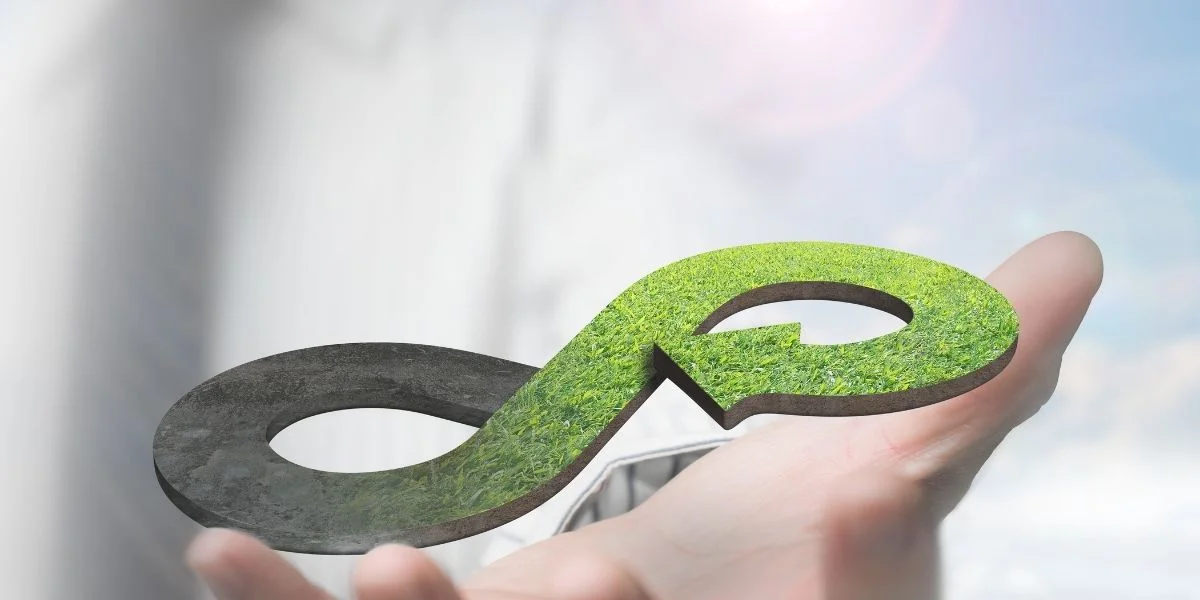Buy, use, throw away. That’s how most of us ultimately consume goods. Manufacturers are constantly keeping pace to produce new products. Raw materials—already scarce—become scarcer as the climate crisis grows worse. At the same time, literal mountains of garbage pile up at colossal landfills worldwide. It’s not sustainable, and we’re rapidly approaching a breaking point. Shein, Primark, Zara, H&M are just a few of the culprits in Western closets. There’s no way around a circular economy in fashion and other manufacturing industries.
Table of Contents
What Does Circular Economy Mean?
Think of the circular economy as a closed-loop system where products are made to be re-used, repaired, or recycled back into the system instead of being sent to landfills. It’s different from the linear economy, where products are made, used, and then thrown away.
The circular economy is often spoken about in relation to the environment. Yet it also has major implications for the fashion industry. If clothes are made to be re-used or recycled, this obviously reduces the need for new clothes to be manufactured. In turn, this dampens the negative impact the garment industry has on the environment, and on its workforce.
In the fashion industry, the circular economy is gaining traction as a way to reduce the environmental impact of clothing production. By designing clothes that can be easily repaired, re-used or recycled, fashion brands are working to close the loop on textile waste.
A minimalist wardrobe of essentials is a great example of the circular economy in action. By opting out of fast fashion and investing in high-quality, timeless pieces that can be worn again and again, you can create a wardrobe that will last for many years.
More Efficiency, Less Waste and Pollution
In a circular economy, existing products remain in circulation as long as possible. This can also encompass leasing models, sharing or subscription services. Before further re-use, goods might be refurbished, repaired, or entirely recycled. The goal is the same: to extend products’ lifecycles. Over the course of lifecycle management, they remain in this economic loop as long as possible and achieve further added value through their re-use.
In short, circular economy is a term used to describe an economy in which resources are used and re-used in a closed circuit, rather than being dumped or incinerated. So in a circular economy, waste is quasi designed out of the system while products are made to last.
FURTHER READING
If you’re interested in learning more about the circular economy, the Ellen Macarthur Foundation has a fantastic information hub with real examples and further research.
What Is Circular Fashion?
Circular economy clothing ties in nicely with a more minimalist wardrobe and decluttered closet. As outlined in my post on creating a conscious closet, if you only buy quality clothes you know you’ll wear for a long time, you’re playing a good part in protecting both the environment and garment workers.
The circular economy in fashion is a hot topic right now, for good reason. Fast fashion, the quick turnaround of designs from the catwalk to stores, is incredibly wasteful. Cheaply manufactured, typically in terrible conditions for the underpaid workers who produce them, inexpensive textiles are often merely worn once or twice before being discarded.
The circular economy offers a more sustainable way to produce and consume fashion.
Not only does it help reduce textile waste in dumps, but it also has the potential to create new jobs. In a traditional linear system, most of the value is forged at the beginning and the end of the supply chain. In contrast, value is created in a circular system throughout the entire process of repairing, recycling, re-purposing and re-using. This adds more labour and opportunities along the way. Subsequently, it can equate to more jobs.
The circular fashion industry also bears potential economic benefits. By reducing the cost of landfill and waste treatment, companies potentially save money. In turn, they can re-invest in the business and the community. Better pay for workers is also possible.
More Sustainability with Circular Economy in Fashion
There is no way around a circular economy, especially considering the growing scarcity of raw materials in parallel to a growing world population and subsequent increase in demand.
In the garment industry, pre-consumer recycling focuses on leftover fabrics and scrap textiles to upcycle or create entirely new fibre. By using these materials, companies help reduce CO2 emissions and thus ensure greater sustainability.
FURTHER READING
Are your donated clothes really being recycled? The Good Trade has the scoop and also explains what greenwashing is and why H&M’s clothing collection points aren’t really helping anything.
How Europe Is Moving to Adopt a Circular Economy
The European Commission presented the European Green Deal in late 2019. Its aim is to accelerate “green” transformation in the economy and ultimately become the first climate-neutral continent in the world. Acknowledging that our economy is still predominantly linear in design, the deal set out to do something about the small proportion of materials and resources being re-used.
This year the Commission presented its first package of measures to accelerate the transformation to a circular economy. Among the proposals is a push to make clothing production more durable, recyclable, and sustainable in the EU by 2030, in an effort to combat the tons of textiles being dumped and incinerated every day. Mandatory minimum levels of recycled content are planned. There are also goals to make clothes easier to mend.
It will be interesting to see how this all pans out for the EU, and if other countries and regions will follow its regulatory lead or leave it up to the industry to police itself.
Back to Your Closet
Leasing has been possible for cars for a long time. But there are also other areas where goods can be used for a certain time and then passed on. Grover, for example, started in Europe but is making a name for itself in the US with its streamlined electronics rental packages (“rent, relax, recirculate”). And who hasn’t heard of Rent the Runway? Yes, renting is also possible when it comes to fashion.
Renting Clothes
Imagine you need a nice dress or a sharp looking tux for a one-time event. Items like this are expensive to buy and usually wind up hanging in your wardrobe for years after only have been worn once.
Why not simply rent the fancy apparel next time you need it? Once you return it, it will be cleaned and the next person can get some use out of it. Over and over again, until it is ready to be retired to recycling.
If you’re into keeping your closet uncluttered or intend on creating a more minimalist wardrobe, the circular economy in fashion should also interest you. A minimalist wardrobe is one that contains quality classic essentials. This type of wardrobe is not only more sustainable, but it is also more economical over the long term. When you have a smaller number of items in your wardrobe, you are more likely to take better care of them and to use them more often. This reduces the need for new clothing and saves you money.
Plus, if you’ve been struggling with a no-closet bedroom situation, a minimal wardrobe is perfect for that lack of storage space.
Smart Shopping and Thrifting
There are many other ways to start incorporating the circular economy in fashion in your own closet. One way is to buy clothes made from sustainable materials that can be re-used or recycled.
Synthetic fibres like polyester are made from oil and are thus actually plastic. Not only do they need twice the amount of energy in production as cotton does, but they also take up to 700 years to decompose once you throw them out!
Another way is to incorporate the circular mindset in your closet is to buy vintage or second-hand clothing instead of new.
Before you turn your nose up at used garments, let me assure you there’s a huge market out there with wonderful stuff in superb condition. Have a browse through Fashionphile or Vestiaire Collective for your favourite designers to see what I mean. They’re also great for re-selling your own garments and accessories if you’ve decluttered your closet!
Mending, Re-purposing and Donating
You can also repair and care for your clothing so that it lasts longer. And if it’s beyond repair you might still be able to re-use it. I cut up tattered t-shirts and use them as cleaning rags at home and for washing my car.
Let’s also not forget that the less laundry you do, the better it is for your garments, your utilities bill, and the environment. Washing leads to microfibre shedding. That’s bad for our water, and it makes your clothes pill.
Finally, you can donate unwanted clothing in good condition instead of throwing it away. Beware though: because of the velocity with which fast fashion has taken over in the last two decades, most charities can no longer keep up with textile donations and they wind up getting thrown out. If you want to give your things away, take a more targeted approach and ring up your local shelters to see who could use your stuff.
Conclusion
We can all agree that a climate-neutral future is one of the highest priority challenges of our time. The circular economy in fashion is one way that help get us there. A system in which resources are used and re-used in a closed loop.
To get into that loop though, we need to change the way we make and use things. We need to move away from the “take-make-dispose” route of the linear economy, and pivot towards a more sustainable, circular model.
Scrutinizing what you spend your hard-earned money on and trying out any of the above tips next time you organise your closet and weed out clothes are two ways you can lean into this transformative movement, help make the fashion industry more sustainable, and reduce your personal impact on the environment.












Leave a Reply